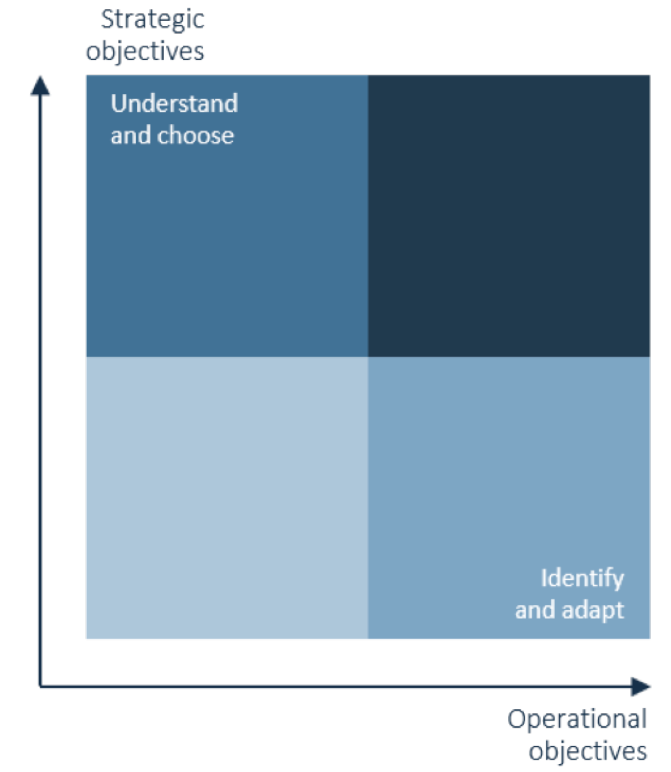Developing a segmentation model is one of the most rewarding and interesting tasks you can do as a consultant. But it can also be a highly frustrating process.
Arriving at a model everyone in the organization agrees to is hard work. As a consultant your diplomatic meeting-room-skills, balancing different considerations and needs, seem to be as important as your technical skills. It seems that at least some of the internal stakeholders are bound to leave the process slightly disappointed with the outcome.
The problem is that people from different parts of the organization expect different things from the segmentation model. To be sure, people agree that segmentation is about finding a logic for grouping consumers (or businesses, if you are a B2B player) in clearly distinct segments. People across different parts of the business tend to be highly enthusiastic about having segments to navigate by. People part ways, however, when it comes to what exactly they expect to be able to do with the segments.

Strategic or operational?
As I see it, you can either approach segmentation from a strategic or an operational position. In the former, your objective may be to develop a positioning strategy for the company, in the latter you may look for a practical tool that helps you optimize your day-to-day CRM activities. Which position you come from has practical implications for the choice of methodology. A methodology that is appropriate in the strategic realm,
may not offer operational value, and vice versa.
I talk through the table above at the start of every segmentation project, to try to force the client to clearly articulate the core motivations for wanting a segmentation model, and to uncover any hidden conflicting assumptions among those participating in the process.
First off, it is important to understand the strategic-operational divide. If the underlying motivation is strategic, your aim is to understand the market, how consumers think and act. This understanding will help you make important high-level decisions, such as what position to strive for, what to invest money and resources in, and the long-term strategic focus for the organization. On the other hand, if you’re underlying motivation is operational, your aim is to accurately identify the segment affiliation of consumers. Segments are a practical tool that helps you target and customize your offering to them more effectively.
Strategic segmentation implicitly requires you to choose which segment to target, as it will be practically impossible to serve all segments. Operational segmentation requires you to be agile and adapt to (all) the segments you are dealing with.
The yardstick of a strategically motivated segmentation model is conceptual clarity, as a catalysator of strategic thinking. The yardstick of an operationally motivated segmentation model is identifiability, that the segments can easily be re-created across different touchpoints.
Strategically motivated segmentation models tend to be inductive, in the sense of trying to understand the market on its own terms. You look for hidden patterns and construct segments bottom-up based on no prior theory. Operationally motivated segmentation models tend to be deductive, in the sense of starting off with some identifiable traits and constructing the segments top-down, always with practical identification in mind.
Seeking to understand consumers on their own terms, strategically oriented models are typically based on consumer needs, while operationally oriented models are typically based on easy-
identifiable consumer traits. There are different levels to both consumer needs and traits. A strategic model can look at consumers’ general attitudes, category needs specific to the category in question, or situational needs specific to the consumer occasion. An operational model can look at concrete behaviour captured in internal data, geographic location, or demographical characteristics.
The chosen input data for the model will naturally limit the ability to re-create the segments across different channels, or the scalability of the model. A model based on situational needs are per definition not scalable, as you don’t identify stable consumer needs, but rather needs arising in a specific user context. Consumers will naturally float from one need state to another, and there is therefore no way to link a situationally defined segment to concrete consumers. In categories where consumer needs are more stable and don’t depend (as much) on context, category need segments may to a certain degree be scalable, so too with segments constructed from general attitudes. Scaling requires you either to reduce complexity or to find keys exogenous to the segment definition (such as demographical variables) that can be used to recreate the segments in other channels, which necessarily means that you sacrifice accuracy. Consumer traits, on the other hand, tend to be highly scalable, as they are readily available across a host of different channels.
Can you have the best of both worlds?
Talking through all the elements that differentiate a strategically and operationally motivated segmentation, makes it apparent that people in the organization approach the project with very different mindsets. It is important to acknowledge these differences early-on, instead of having a hidden tug-o-war between different perspectives compromissing the whole process.
 The difference in perspective can be illustrated by a simple 2 by 2 table.
The difference in perspective can be illustrated by a simple 2 by 2 table.
A timely question is whether it’s possible to hit the upper-right quadrant – having a segmentation model that satisfy both strategic and operational objectives. That would either require a hybrid solution, or the ability of making a strategic model operational, or vice versa.
Since the strategic and operational needs clearly diverge, which has practical implications for the choice of methodology, I’m sceptical to the prospect of having one model to “rule them all”. Making an operational model strategic is to my mind the worst alternative, as consumer traits such as demography offer little understanding of how the market think and acts, and is poor inspiration for strategic thinking. If you try building a hybrid model that will work well at both the strategic and operational level, you have to make methodological compromises in both directions, and risk developing a model that performs poorly in both realms. Making a strategic model (based on general attitudes or category needs) operational by scaling it is possible, at least to some degree, and in some channels. You have to sacrifice accuracy, though, often so much so that the resulting operational segments have little in common with the segments defined at the strategic level.
In conclusion, aiming for the upper right quadrant may in many instances be utopian. You run the risk of hitting the lower left quadrant instead, ending up with a model that performs poorly both as a strategic roadmap, and as an operational tool for targeting and customization.
Whoever said that you can only have one segmentation model?
I have a beef with whoever made the claim that an organization must only have one segmentation model. That people can’t get their head around more than one model. I beg to differ. To my mind a segmentation model is a specialized tool to solve a particular business issue. As businesses face multiple issues, it makes sense to have multiple tools. As the saying goes ”if you have a hammer, every problem looks like a nail”. You wouldn’t trust a carpenter equipped with only a hammer to build your house.
The core insight that spurs businesses to run segmentations projects, is that that consumers are different and you cannot satisfy every need with the same product. I believe the same is true for the consultant helping to develop a segmentation model. The client organization is not a homogenous entity with one clearly defined set of needs. You cannot therefore satisfy every organizational need with the same model. Which means that you must choose. More specifically, you need to decide what is most important, satisfying the strategic or the operational needs of the organization.
If the business issue at hand is how to develop a positioning strategy, you want a model that offers conceptual clarity and is built to last. This will help you make important high-level decisions. If the business issue at hand is how to target and customize the offer or marketing activities more effectively, you want an agile model that can accurately identify consumers across different channels. This will help you adapt your offering to whatever consumer you’re dealing with. Don’t expect the same model to do both.


